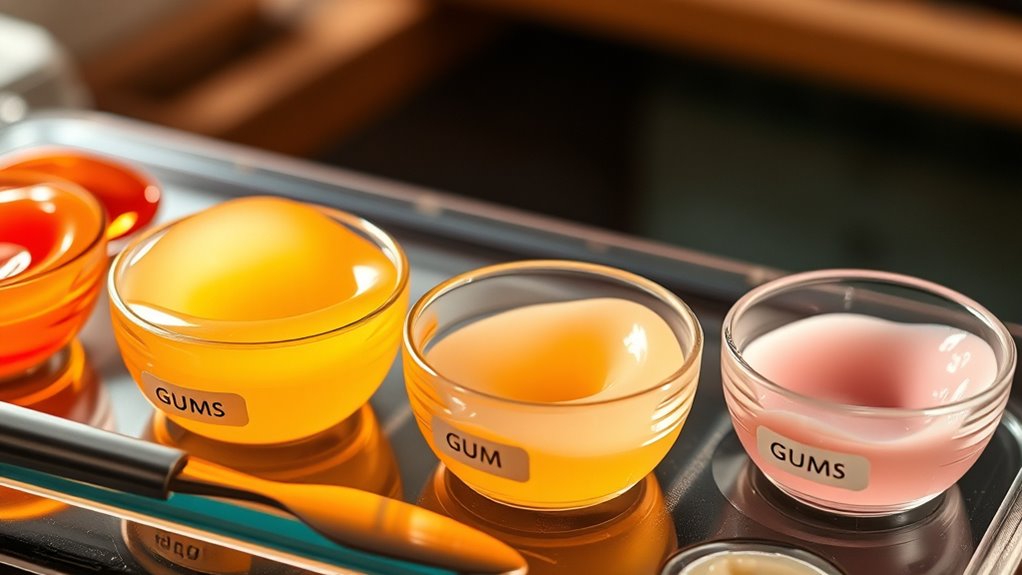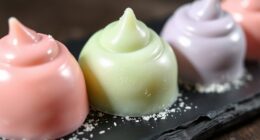To achieve optimal texture, combine different gums and stabilizers, like gelatin, pectin, and xanthan, strategically based on your product needs. For example, blending gelatin with pectin can create complex, stable gels with appealing mouthfeel, while adding gums like xanthan can improve viscosity and prevent syneresis. Adjusting ratios allows you to fine-tune firmness and clarity. Want to discover more tips for perfecting stabilizer combinations? Keep going to reveal expert insights.
Key Takeaways
- Combining gums like gelatin and pectin allows customization of texture, firmness, and stability in food products.
- Adjusting gum ratios influences gel strength, elasticity, and mouthfeel to meet specific product requirements.
- Blending stabilizers can enhance clarity, reduce syneresis, and extend shelf life of gels and desserts.
- Experimenting with different gum combinations helps achieve multi-layered or complex textures.
- Understanding interactions between gums ensures optimal stabilization and prevents undesirable effects like phase separation.

Stabilizer combinations are essential for enhancing the performance and durability of various products and systems. When it comes to food textures and structural integrity, mixing different stabilizers allows you to fine-tune the consistency and mouthfeel, ensuring the final product meets your desired standards. Two common stabilizers you might consider are gelatin blends and pectin ratios. Understanding how these work together can dramatically improve your culinary creations, from jellies and gummies to mousses and desserts. Incorporating natural materials such as gelatin and pectin aligns with farmhouse-inspired themes, emphasizing authenticity and wholesome ingredients. Gelatin blends are especially versatile because they provide a smooth, elastic texture that melts in your mouth. By combining different types of gelatin or adjusting their concentrations, you can control the firmness and stability of your product. For instance, a higher gelatin concentration results in a firmer gel, while lower amounts create a softer, more delicate structure. Blending gelatin with other gums or stabilizers can help prevent unwanted syneresis, the separation of liquid, and extend shelf life. When you tweak gelatin blends, you’re essentially customizing the texture to match your specific needs, whether you want a jiggle that’s firm enough to hold shape or a softer, more delicate consistency. Pectin ratios, on the other hand, play a key role in setting fruit-based gels and jams. Pectin is a natural carbohydrate found in fruits, and its gelling ability depends heavily on the pectin ratios you choose. Low-methoxyl pectin requires calcium ions to gel, whereas high-methoxyl pectin depends on sugar and acid content. By adjusting these ratios, you can control the firmness, clarity, and spreadability of your product. For example, increasing the pectin ratio may produce a thicker, more spreadable jelly, while lowering it results in a softer, more pourable consistency. When you combine pectin with gelatin blends, you can achieve a multi-layered texture that’s both stable and appealing, especially for complex desserts or fruit preserves. In practice, mixing these stabilizers isn’t just about quantity; it’s about understanding how they interact. For instance, combining gelatin blends with specific pectin ratios can give you a gel that’s firm yet tender, with improved clarity and stability. You’ll want to experiment with different ratios to find the perfect balance for your product. Adjusting gelatin blends and pectin ratios allows you to customize the texture, ensuring your product is not only attractive but also enjoyable to eat. By mastering these combinations, you’re better equipped to create consistent, high-quality foods that stand out in both appearance and mouthfeel.
Frequently Asked Questions
Can Stabilizer Combinations Affect Shelf Life?
Yes, stabilizer combinations can affect shelf life. When you choose the right mix of stabilizers, you improve shelf stability and preservation techniques, preventing spoilage and texture degradation over time. Properly balanced stabilizers help retain moisture, inhibit microbial growth, and maintain product quality. So, by carefully selecting stabilizer combinations, you enhance your product’s longevity, ensuring it stays fresh and safe for longer periods.
Are There Vegan-Friendly Stabilizer Mixes Available?
Yes, vegan-friendly stabilizer mixes are available. You can choose from various plant-based stabilizer blends that incorporate vegan ingredient options like agar-agar, guar gum, xanthan gum, and pectin. These natural, vegan ingredients help you attain the desired texture without any animal products. By selecting the right plant-based stabilizer blends, you guarantee your recipes stay both vegan and delicious, offering a great alternative to traditional stabilizers.
How Do Stabilizers Influence Flavor Profiles?
Imagine a dish where stabilizers don’t just support texture but also influence flavor profiles. They can subtly enhance flavors or modify tastes, creating a more balanced or intensified experience. By affecting the mouthfeel and release of aromatic compounds, stabilizers contribute to flavor enhancement and taste modification, shaping how your palate perceives the final product. So, your choice of stabilizer can make a significant difference in the overall flavor journey.
What Are the Cost Differences Between Stabilizer Options?
When comparing stabilizer options, you’ll notice significant cost differences based on stabilizer pricing and quality. Some gums, like agar or gelatin, are more affordable, while specialty stabilizers such as carrageenan or xanthan gum can be pricier. The cost comparison depends on your recipe needs and budget, so choose stabilizers that balance quality with affordability to achieve the desired texture without overspending.
Do Stabilizer Mixes Require Special Storage Conditions?
Yes, stabilizer mixes require proper storage conditions to maintain their effectiveness. You should store them in a cool, dry place away from direct sunlight, moisture, and heat. These stability concerns can cause the stabilizers to degrade or clump, reducing their performance. Always keep the containers tightly sealed and follow the manufacturer’s guidelines to guarantee your stabilizer mixes stay fresh and effective for future use.
Conclusion
Imagine the perfect swirl of creaminess and bounce on your tongue, crafted by just the right blend of gums. When you mix stabilizers thoughtfully, you create a symphony of texture that feels like a gentle embrace. So, experiment with different combinations, and watch your creations transform into velvety, resilient delights. With each stir, you’re not just stabilizing — you’re painting a masterpiece of mouthfeel that keeps everyone coming back for more.









